8. Dressed to Kill (1980)
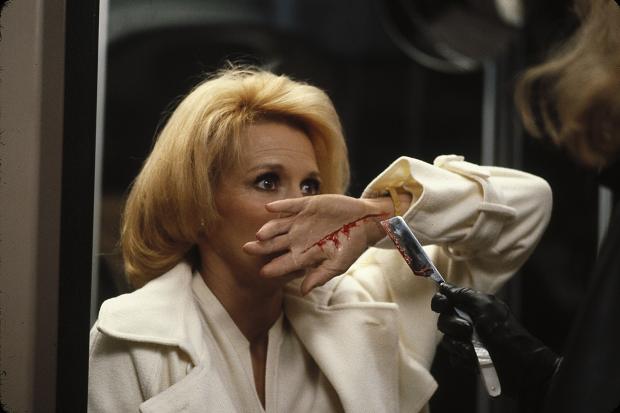
A controversial film upon its release that found director Brian De Palma labelled a misogynistic chauvinist, a sell-out, and a Hitchcock plagiarist by his critics, his vast legion of fans and his peers all know better today as they did then. To his many admirers and to the critical establishment beyond the populist American crowd he is regarded as an auteur, an avant-gardist, an au fait satirist, a passionate independent iconoclast and an articulate intellectual.
Dressed to Kill is as sharp and explicit as it gets and still manages to keep its tongue firmly planted in its cheek all the while. From its fetishized slo-mo opening with a soft-core flourish as housewife Kate Miller (Angie Dickinson, excellent) has a sudsy fantasy in the shower to her brutal Psycho-esque butchering –– complete with vivid violin score –– in an elevator before the first act has finished, this is a masterfully made symphony of sensuality and terror.
Eye witness Liz Blake (Nancy Allen), who doubles as an unreliable escort, Kate’s intelligent teenage son Peter (Keith Gordon), and Kate’s eccentric psychiatrist Dr. Robert Elliott (Michael Caine) may hold the secret to Kate’s death. But who do we trust amongst these three, if any?
Dressed to Kill dips into dark fantasy on several occasions, combining sensuality and danger at every turn, smashing taboos –– gender dysphoria is portrayed with acrimony –– and it’s all done with such wild and varying techniques and flourish that it will leave you gasping for air.
7. Se7en (1995)
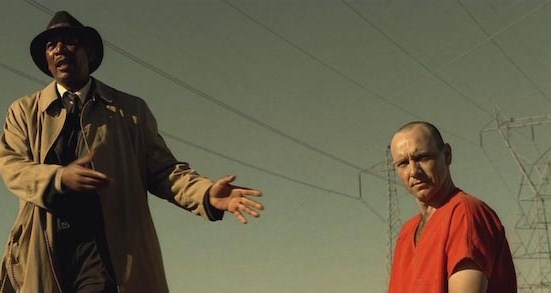
Not just an atypical entry in the neo-noir crime genre, generous helpings of horror and heartache – the eerie “what’s in the box?” ending especially – helped make Se7en become director David Fincher’s breakthrough film. Met with critical success as well as being one of 1995’s highest grossing films, Se7en also gave audiences anxiety and new nightmares aplenty.
Set in a fictitious American city – though filmed primarily in Los Angeles – Se7en seduced a buddy-cop formula pairing about-to-retire Detective William Somerset (Morgan Freeman) with feisty and idealistic Detective David Mills (Brad Pitt). David, recently transferred to the department, has much to prove, and their first case established a sicko serial killer bent on arranging elaborate and grisly murders focused on the seven deadly sins.
Se7en also features Gwyneth Paltrow in her first major role, as David’s doting wife, Tracey, and an especially sinister turn from Kevin Spacey as a John Doe and prime suspect.
All in all this was an impactful and influential film, not only showcasing stirring and emotional performances from its fine ensemble, but it vested Fincher as a bankable, and ingenious director capable of uncompromising, utterly chilling, yet satiating work. It’s rightly considered a genre classic and is essential viewing for anyone who likes their psychological thrillers cynical and sardonic and hard to shake off.
6. Memories of Murder (2003)
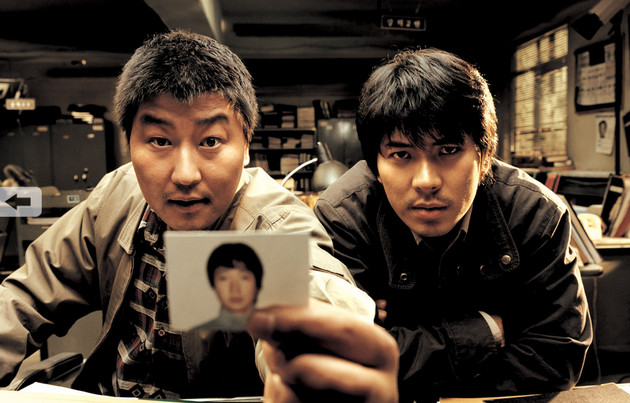
Bong Joon-ho (Mother [2009], Snowpiercer [2013], Okja [2017]) rose to international fame, as did his lead actor Song Kang-ho, in this startling South Korean thriller that, like several startling films on this list, is based off of actual events.
Memories of Murder begins in the autumn of 1986 when a woman’s body is discovered in a field outside of Hwaseong, a city fringed by bucolic fields and farmland. Local detective Park Doo-man (Kang-ho) is out of his depth with the brutal crime – soon to be the first of several – and his bungling, ill-equipped team are soon bolstered by Detective Seo Tae-yoon (Kim Sang-kyung) from the mean streets of Seoul.
The film, a favorite of many auteur-adoring critics and filmmakers alike, including Quentin Tarantino, is wonderful and wise mixture of police procedural, detective film, black comedy, and social satire. It’s an elusive, at times frustrating film –– the real-life crimes and those in the film never get satisfactorily solved –– Memories of Murder is one of the freshest and most formal serial killer/detective films around, with enough surprises and shocks to keep viewers riveted and rattled until its final polished frame. A masterpiece.
5. The Night of the Hunter (1955)
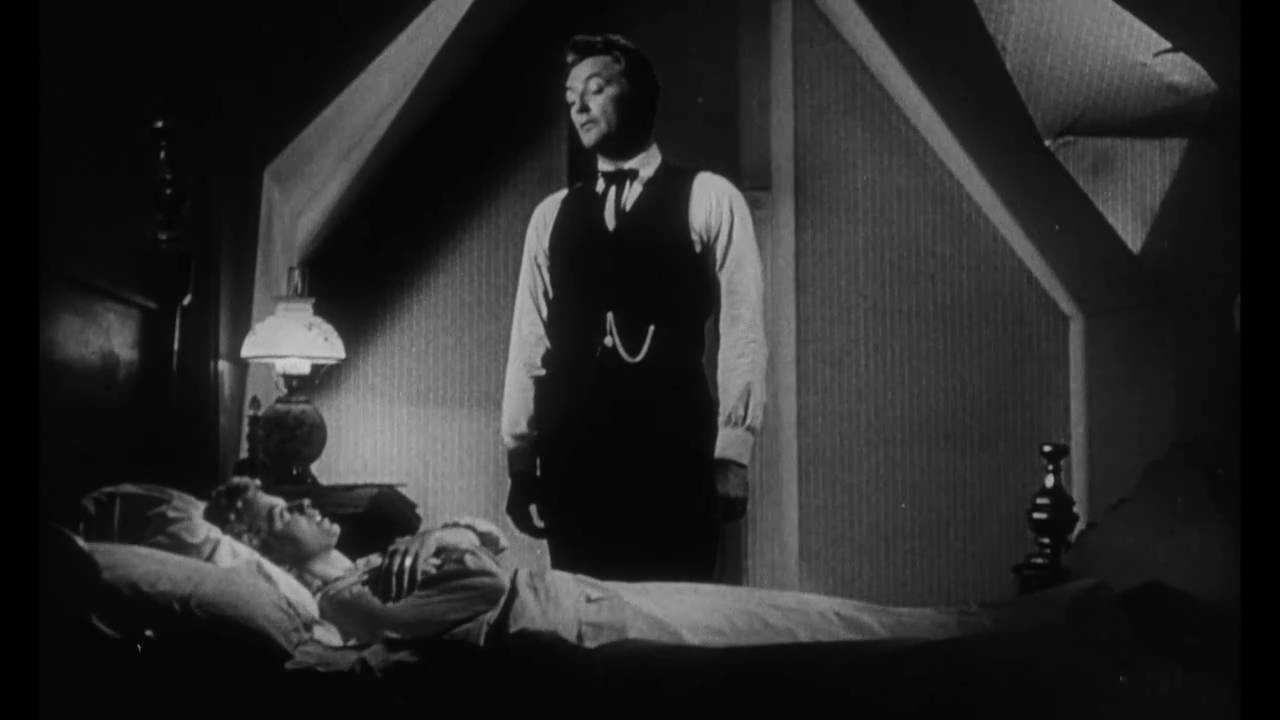
Charles Laughton’s The Night of the Hunter is a whirling pictorial dervish, as well as a beautiful traumatic fable about a brother and a sister. Set in the Dust Bowl era, America is in the clinches of the Depression, but this here is no history lesson. No, this is a tale of two children, weakened and pursued by hysterical religiosity and the ignorance of the adult world.
Clearly a work of awe and evil, of enchantment and horror, The Night of the Hunter is one of those unshakable cinematic experiences that was misunderstood in its day but in the years since has been declared a masterwork. An opiate-addled fairytale for grown-ups from the perspective of off-course and unloved children, Laughton together with legendary cinematographer Stanley Cortez , strove for and achieved a merger of German Expressionism and Film Noir composite.
The results? It’s a work that is overflowing with high-contrast, jagged angles, strange shadows, distorted perspectives, and startling, surrealistic sets. The resulting distortion of reality works flawlessly to exaggerate the emotional onscreen experience.
An atmosphere of browbeaten dread and mounting terror overwhelms and transforms The Night of the Hunter into a surrealist standard.
The plot is simple; “Reverend” Harry Powell (Robert Mitchum) is a religious fanatic who becomes a full blown serial killer who targets the widow (Shelley Winters) of a petty thief he did some time with. Soon Willa’s two children, John (Billy Chapin) and Pearl (Sally Jane Bruce) must escape Harry before it’s too late.
Thick with nocturnal panic, The Night of the Hunter preys on things like our childlike fears of the dark, and the adult assertion of cruelty and persecution. A chilling tour de force you’ll never forget (Shelley Winters, strapped to her car and floating amongst seaweeds is one of cinema’s most unsettling tableaus, almost beautiful if it weren’t so brutal).
4. Blue Velvet (1986)
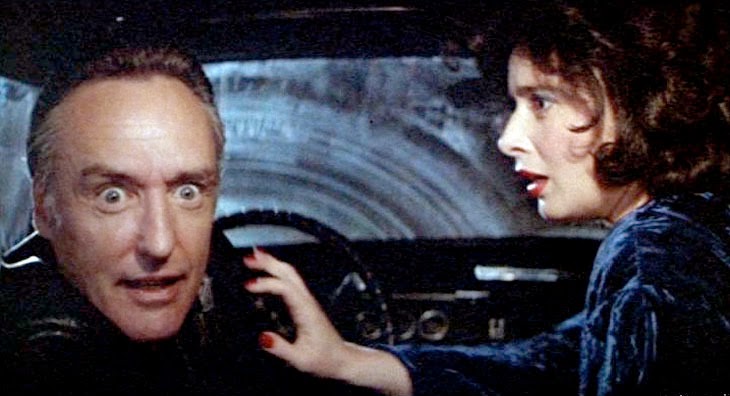
Entrenched with seeming innocence in small-town America, David Lynch’s darkly disturbing Blue Velvet courts controversy as much as it parades sickness and sadism. Beneath the well-manicured lawns and white-picket fences of Lynchian middle America, in this case the idyllic bliss of Lumberton, there lurks horror, hurt, danger and death.
Jeffrey Beaumont (Kyle MacLachlan) and Sandy Williams (Laura Dern) are naïve youngsters, a romantic tension builds between them but so does a mystery as they do some amateur sleuthing in their sleepy little town. Jeffrey has returned to Lumberton from college, owing to his father’s recent stroke, and he’s barely back in town before he makes a startling discovery; a severed human ear in the field near his father’s hospital.
His curiosity, arguably unhealthy, soon finds him embroiled in the life of put-upon lounge singer Dorothy Vallens (Isabella Rossellini), whose husband and child have been taken hostage by wolffish psychopath Frank Booth (Dennis Hopper, in what might well be his most memorable and menacing role).
One of Blue Velvet’s most memorable scenes finds Jeffrey hiding in Dorothy’s closet, a perverse Peeping Tom, he witnesses Frank’s savagery first hand and is powerless to intervene. As far as onscreen voyeurism and indicting us as spectators to the crime is concerned, Blue Velvet is a masterclass and arguably Lynch’s finest and most unforgettable film.
3. Silence of the Lambs (1991)
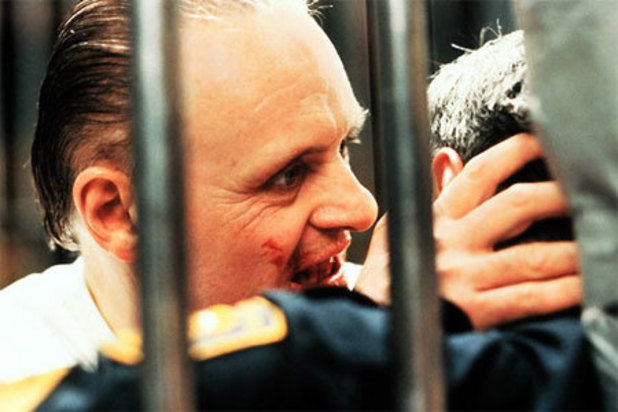
“I go to the cinema because I feel like being shocked,” said Silence of the Lambs director Jonathan Demme while doing the press junket for the film, and that’s as good a mantra as any for Silence of the Lambs when considering the Freudian context, the atmospheric dread, the upsetting camera angles and the unnerving and artfully articulated manifestation of evil that permeates every frame of this monstrous procedural/serial killer thriller.
While it’s Ted Levine’s terrifying Jame Gumb aka “Buffalo Bill” that first gets the FBI rookie Clarice Starling (Jodie Foster) on the case, it’s her encounters with Dr. Hannibal “The Cannibal” Lecter (Anthony Hopkins, in an iconic performance) in the windowless basement confines of the high security mental hospital that may be the most memorable aspects of this nightmarish motion picture.
A cinematic high point for American film of the 1990s, the dual psychopaths at the center of this film are unforgettable human monsters, and the closing line of Lecter about “having a friend for dinner” may be the most ghoulish coda in history. To call it “chilling” may well be an understatement.
2. Psycho (1960)
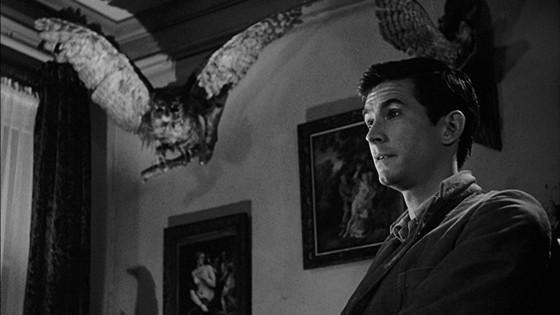
From the shrill violins punctuating Bernard Hermann’s distinguished and unforgettable score to Anthony Perkins’ momentous turn as the amiable and all too charming Norman Bates and all the creeping buildups to unforeseen shocks along the precarious way, Alfred Hitchcock’s Psycho is easily the most influential horror film in history.
The first ever splatter film, Psycho set the template for the slasher subgenre while gleefully breaking every rule in the book as far as upsetting audience expectation at every turn. Toppling romantic principles straight away, Psycho opens on Marion Crane (Janet Leigh), an alluring and likeable young woman who is stealing $40, 000 from her boss and having an illicit affair with a married man to boot.
Not exactly morally upstanding, Marion is still sympathetically rendered and wholly engaging, good-natured even. But before too long she finds herself seeking refuge at the Bates Motel and taking the most famous and ill-advised shower ever photographed.
And old Hitch pulls the carpet out from under us as a half hour into the movie the pleasing protagonist is massacred most ferociously, forcing us to suddenly identify with an accomplice we just can’t be too sure of. What the heck, Hitchcock? You’re totally breaking all the rules and manipulating us like a pitiable plaything.
The now emblematic Bates house was inspired by Edward Hopper’s Americana paintings, details of the crimes had their genesis in real-life Wisconsin serial killer Ed Gein’s atrocities, all indicating that Hitchcock was perforating the American psyche and subconscious.
Family relations, sex, madness, and bloody murder rest at the bosom of one of Hitchcock’s greatest and grittiest works. Psycho isn’t just the nativity of modern horror, it’s also the recognition and acceptance of it.
1. The Vanishing (1988)
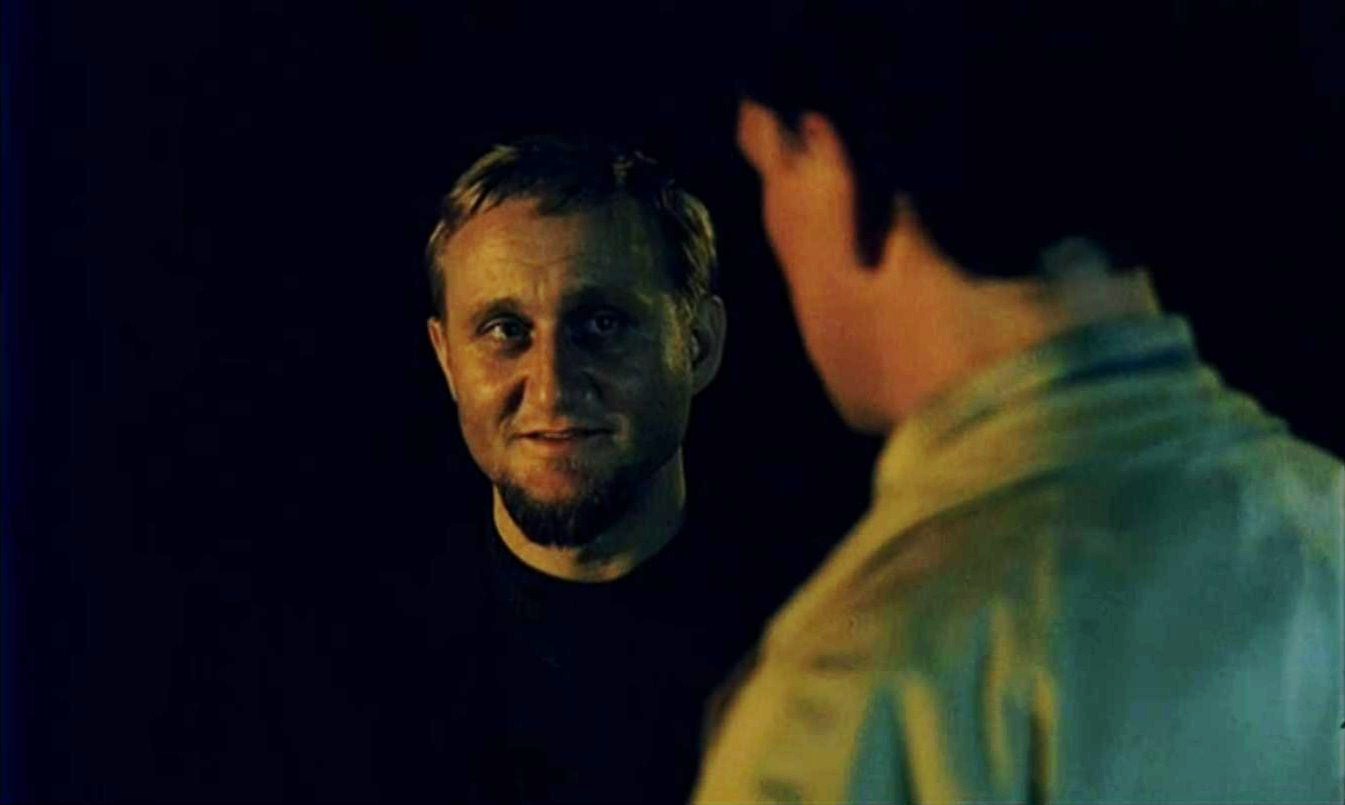
George Sluizer’s Dutch chiller, that he’d later remake for American audiences (with Sandra Bullock no less, and don’t bother watching it, it’s not good owing to a detestable Hollywood ending), is a tightly wound, harrowing ordeal that’s full of surprises and near-bottomless chills.
Adapted from Tim Krabbé’s novella “The Golden Egg”, The Vanishing fixes its bleak gaze upon the disappearance of Saskia Wagter (Johanna ter Steege), a young woman last seen at a service station with her boyfriend, Rex Hofman (Gene Bervoets) while on vacay in France. Soon it becomes Rex’s obsession to discover the fate of Saskia, and as the years go by, his idée fixe becomes all consuming, and shockingly, his troubles have only begun.
The Vanishing’s uncompromising finale boosts it into the upper echelon of Hitchcockian horror to be sure, but the film as a whole also functions as a master class in unsettling moments and slowly ratcheting terror as Rex hunts the slyest of serial killer.
An intellectual thriller of this ilk is rare, that it conjures equal measures of cursory family life and detached doom with such shrewd elegance resulting in one of the most ferocious climaxes of any film ever buoys The Vanishing into the sinister celestial. So much so that Stanley Kubrick famously and enthusiastically said to Sluizer that he’d watched his film three times, adding it was “the most horrifying film I’ve ever seen.”
Author Bio: Shane Scott-Travis is a film critic, screenwriter, comic book author/illustrator and cineaste. Currently residing in Vancouver, Canada, Shane can often be found at the cinema, the dog park, or off in a corner someplace, paraphrasing Groucho Marx. Follow Shane on Twitter @ShaneScottravis.